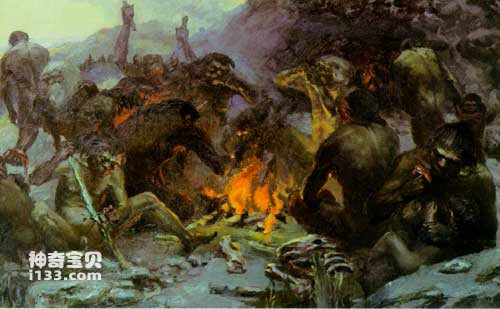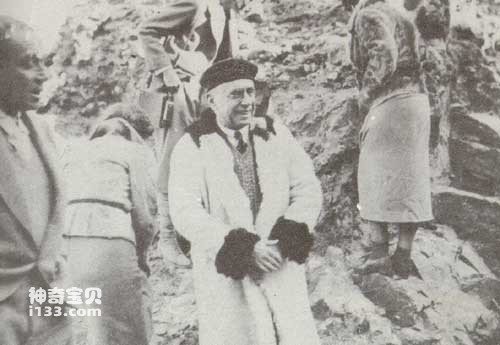Among the relics of the Peking people discovered in Zhoukoudian, there are not only a large number of stone tools, but also many tools made of animal bones or horns - bone tools.
A more important discovery is the evidence that people in Beijing used fire. Among the evidence are ashes, charcoal and burnt bones and stones.
Ashes are often found in layers and contain substances of black, white, gray, yellow, purple and other colors. The ash layer is usually soft and contains more moisture, but is very light when dried. The black ash layer contains a large number of fine charcoal particles, and charcoal blocks from burned redbud trees have also been found; most of the bones and stones found in the ash layers of other colors were also burned by fire. There are many cracks on the surface of the burned bones, some deformed into twisted shapes, and some turned into gray, green, blue, brown or even black, so it is easy to identify; the burned stones also have cracks, and some even Has turned to lime.

Peking Man uses fire
There is no doubt that Beijingers use fire, and because some ashes appear in piles, it shows that Beijingers already know how to prevent fire from spreading around. In other words, Beijingers have learned how to manage and control fire.
The use of fire by humans is an extremely important event. We cannot imagine what humans would be like today without fire. The discovery of evidence of the use of fire by people in Beijing was the earliest record of human use of fire known at that time, and it suddenly advanced the history of human use of fire by more than 1 million years. On the other hand, the ability of Pekingese to manage and control fire shows that Pekingese are not the first human group to use fire, and humans should have started using fire earlier. Such a judgment has led people to continue to explore the origin of human history, which has led to the discovery of earlier evidence of fire use in my country in ancient human sites and ancient cultural sites that are earlier than the Peking Man era. These sites include those older than the Peking Man era. The earlier Zhoukoudian Site 13 and the Nihe Cultural Site in Ruicheng County, Shanxi Province also include the Lantian Man Site in Gongwangling, Lantian County, Shaanxi Province, which dates from 800,000 to 1 million years ago. Later, anthropologists from other countries also discovered many traces of fire use in older Homo erectus sites in Africa and other places. Therefore, we can say without exaggeration that Zhoukoudian’s fire lit up the world.
We can also say that the fire in Zhoukoudian is not just the natural fire lit by Beijingers in a broad sense. The discovery of Beijingers and their culture is itself a fire: it is the fire of the discipline of anthropology and the development of human understanding of itself. The tinder of history. It was the discovery of the first Peking Man skull and the subsequent discovery of Peking Man's stone tools, bone tools and evidence of fire use that raised the importance of the Peking Man site to a new level in scientific research, thus bringing the entire world to a new level at that time. The world's prehistoric archaeologists, paleoanthropologists and people interested in human evolution have all attracted the attention of Zhoukoudian, a small place, which has led to a greater harvest of ancient human fossils and cultural relics in Zhoukoudian.
Until the "July 7th Incident" in 1937, when Japan launched a full-scale war of aggression against China, the CCP unearthed 5 Peking Man skulls, 15 skull fragments, 14 mandibles, and 147 scattered teeth on floors 3-11 of the Peking Man site. In addition, some broken body bones were found, including the femur (i.e. thigh bone), humerus, clavicle, and lunate. These fossils represent more than 40 ape-men, men, women and children. At the same time, more than 100 animal fossils and various plant fossils, as well as tens of thousands of stone tools and a large number of relics of the use of fire, were discovered, making Zhoukoudian a typical place for the Homo erectus stage that cannot be replaced by any other place in the world.

Wei Dunrui
In early 1935, the famous German-American anthropologist Wei Dunrui, who succeeded Bu Dasheng in China, carefully studied these fossils, described the morphological characteristics of Peking Man in detail, and established the status of ape man as the ancestor of Homo sapiens. By comparing with Javanese man, he realized that although there are some differences in morphology between Pekinese man and Javanese man, they are just geographical variations at the same evolutionary level. This scientific conclusion rescued Javanese Man from the misclassification of "Great Gibbon", allowing him to stand tall among the ranks of human ancestors together with Peking Man. Although Wei Dunrui still used Dasheng's name for Peking Man - Peking Man - in his research paper, in fact he had suggested merging Peking Man and Java Man, and treating them as just two species of Homo erectus. Treated as a subspecies. Modern anthropologists have completely determined the classification scheme of Peking Man and Java Man as two subspecies of Homo erectus.
Wei Dunrui also found that many of the physical characteristics of Peking Man are consistent with those of the modern Mongolian race, such as spade-shaped upper incisors, obvious sagittal ridges on the skull, a wider and more vertical nose, and zygomatic bone orientation. It is believed that there is a continuous genetic relationship between them, and the polycentric theory of the origin of human beings is proposed (now this theory has evolved into the polycentric theory of the origin of modern humans). His discovery has now been confirmed by a series of human fossils from different eras discovered after the liberation of our country. Therefore, we can proudly say that Peking Man is the ancestor of us Chinese people, and Zhoukoudian is one of the earliest birthplaces of the Chinese nation.
In addition, in 1933, the famous Shanding Cave Man fossils, which we will talk about later, were discovered in the top cave above the Longgu Mountain Peking Man ruins.
animal tags:
We created this article in conjunction with AI technology, then made sure it was fact-checked and edited by a Animals Top editor.